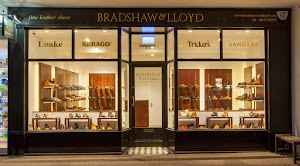The first step in Goodyear welting is to prepare the insole for stitching. This is done by creating a rib perpendicular to the face of the insole through which shoemaker’s twine can be stitched. There are three major methods for doing this. First, the rib can be carved out by hand from the face of the insole using specialized shoemaker’s cutting tools. Second, a cut can be made into the edge of the insole and the rib turned back and stabilized with linen tape or other mechanisms. Third, a rib made of stiffened linen tape can be glued (gemmed) onto the insole. When done properly, the gemming is extremely secure and long-lived, and the linen rib can take as many reweltings as a cut-and-turned rib.The second step is in lasting the shoe. This means that the upper (with its lining) is pulled tightly over the last and secured to it, along with the insole. Lasting can either be done by hand using shoemaker’s pliers and elbow grease, or it can be done by a machine. Most ready-made welted shoes use the machine.The third step is the actual welting. Here, shoemaker’s twine is sewn through the welt strip, the upper, and the rib of the insole. This is done with a lockstitch, which means that all of the stitching won’t unravel if one stitch becomes abraded or comes undone. Finally, another row of lockstitching connects the other side of the welt to the outsole. Both rows of lockstitching can be either done by hand or by machine.
The machine is called a Goodyear welting machine and was invented by Charles Goodyear, son of the man who invented the process for vulcanizing rubber, in the 19th Century. His invention revolutionized shoe construction because it made mass manufacturing of shoes possible. Hand welting shoes is time-consuming, back-breaking process that can take more than 20 hours per pair of shoes. Operating a Goodyear welting machine takes skill, but a pair of shoes can be welted in minutes.
Today, very few ready-made shoes are still hand-welted (RE Tricker is one of these). Are hand-welted shoes superior to machine-welted ones? Well, it depends on what you mean by superior. It is possible to have a more sculpted, beveled, narrow waist with hand-welting than it is with machine-welting. Waist appearance is important in shoes, but it is only an aesthetic consideration, not functional. It’s doubtful that machine-welted shoes are any less durable than hand-welted ones, and it is possible that the converse is true.
There are two principal advantages for Goodyear-welted shoes, both emanating from the same aspect of construction. First, they are relatively water-resistant. Because nothing goes through the face of the insole of the shoe, groundwater doesn’t have an easy path into the interior of the shoe. In contrast, with Blake construction, there is a row of stitching through the face of the insole connecting it to the outsole, which allows groundwater to wick into the interior of the shoe. Second, they are relatively comfortable (assuming that the last fits the wearer’s foot well) because there isn’t a row of stitching on the face of the insole to irritate the bottom of the wearer’s foot. In addition, most makers of ready-made shoes put a layer of cork amalgam in the void between the ribs on either side of the insole; and this cork amalgam molds to the bottom of the foot, which sometimes enhances comfort.
Prominent makers of Goodyear-welted shoes include Loake, Allen-Edmonds, Edward Green, Sanders & Sanders, Vass, Grenson, Tricker’s, JM Weston, and Alfred Sargent. In addition, many Italian manufacturers can do Goodyear-welted shoes, although they can also use many other construction techniques. Sebago use their own unique construction methods.
Visit www.bradshawandlloyd.com to view the latest range of shoes from:


